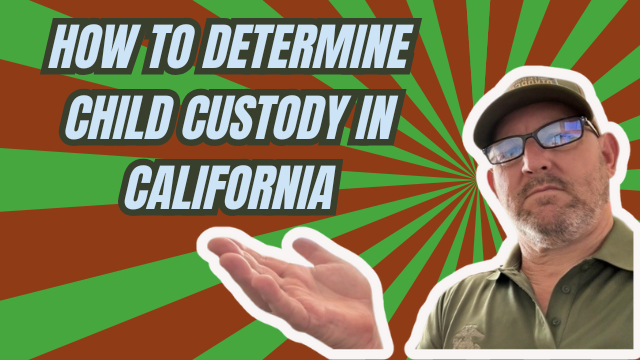How to Determine Child Custody in California
In my video for Divorce661, I walk through the essentials of determining child custody in California — what custody really means, how courts decide what’s best, and how you can create a parenting plan that protects your kids and minimizes conflict. Below I summarize those key points and share practical guidance to help you move forward with confidence
Understanding the Two Types of Custody
Custody isn’t just about where your child sleeps. In California the law separates custody into two distinct categories:
Legal Custody (Decision-Making)
Legal custody refers to which parent has the authority to make important decisions for the child — things like education, medical care, religious upbringing, and other major choices. Legal custody can be:
- Joint legal custody: Both parents share decision-making responsibilities and must cooperate on major choices.
- Sole legal custody: One parent has exclusive decision-making power when co-parenting is not feasible or in the child’s best interest.
Physical Custody (Where the Child Lives)
Physical custody determines the child’s primary residence and the day-to-day care arrangement. This can also be:
- Joint physical custody: The child spends substantial time living with both parents according to a parenting schedule.
- Sole physical custody: The child primarily resides with one parent, while the other may have visitation or parenting time.
Joint vs. Sole Custody: What California Courts Prefer
California courts generally prefer joint custody when parents can cooperate because it supports the child’s ongoing relationship with both parents. Joint arrangements encourage shared responsibility and stability, but the court will always prioritize the child’s best interest. Sole custody may be ordered when there are concerns about a parent’s ability to co-parent safely or effectively.
Creating a Parenting Plan That Works
A clear, detailed parenting plan is the backbone of any custody arrangement. It reduces ambiguity, lowers conflict, and increases the likelihood that the court will approve your agreement.
Essential elements to include in your parenting plan:
- Regular schedule: Weekday and weekend routines, school days, bedtime expectations.
- Holiday and vacation schedule: How holidays, birthdays, and school breaks will be shared or alternated.
- Decision-making responsibilities: Who makes major decisions and how disagreements will be resolved.
- Communication rules: Methods and expectations for parent-to-parent and parent-to-child communication.
- Transportation and exchanges: Where handoffs occur and who is responsible for travel.
- Contingency plans: Handling emergencies, illnesses, or changes in circumstances.
A Real-World Example
One arrangement we recently helped formalize kept the children in the family home during the school week while parents alternated weekends. This setup provided continuity and stability for the kids, minimized daily disruption, and reduced conflict between parents. Because the plan focused on the children’s needs and was clearly written, the court approved it without issue.
Making Your Plan Court-Ready
To gain court approval your parenting plan must be legally sound and clearly documented. Important steps include:
- Use precise, unambiguous language that explains schedules and decision-making authority.
- Address foreseeable issues so the court doesn’t have to interpret vague terms later.
- Include methods for resolving disputes, such as mediation or a neutral third party.
- Complete and file the required court forms accurately and on time.
At Divorce661, we focus on crafting child-centered, court-ready parenting plans. We prepare and file your paperwork correctly the first time and offer flat-fee, 100% remote services across California to keep the process affordable and amicable.
Tips for Keeping Custody Child-Focused and Low-Conflict
- Put your children’s best interests first: stability, routine, and strong relationships with both parents.
- Keep communication about logistics factual and focused on the kids.
- Agree in writing to as many details as possible to avoid misunderstandings.
- Use mediation or a neutral professional to resolve disputes before going to court.
Next Steps
If you’re facing custody decisions in California, you don’t have to handle it alone or turn it into a courtroom battle. I offer a free consultation to help you understand your options and start building a parenting plan that protects your children and your peace of mind. Visit Divorce661.com to schedule your free consultation and learn how we can make the process straightforward and child-focused.
Conclusion
Custody in California involves both legal decisions and physical living arrangements. By understanding the difference between legal and physical custody, favoring cooperative solutions, and creating a detailed, court-ready parenting plan, you can achieve an arrangement that supports your children’s well-being. If you want help crafting a plan or filing the necessary paperwork, reach out — I’m here to guide you every step of the way.
“Custody isn’t just about where your child lives; it’s also about who makes crucial decisions for them.”

